Firebee Drones (two kits)
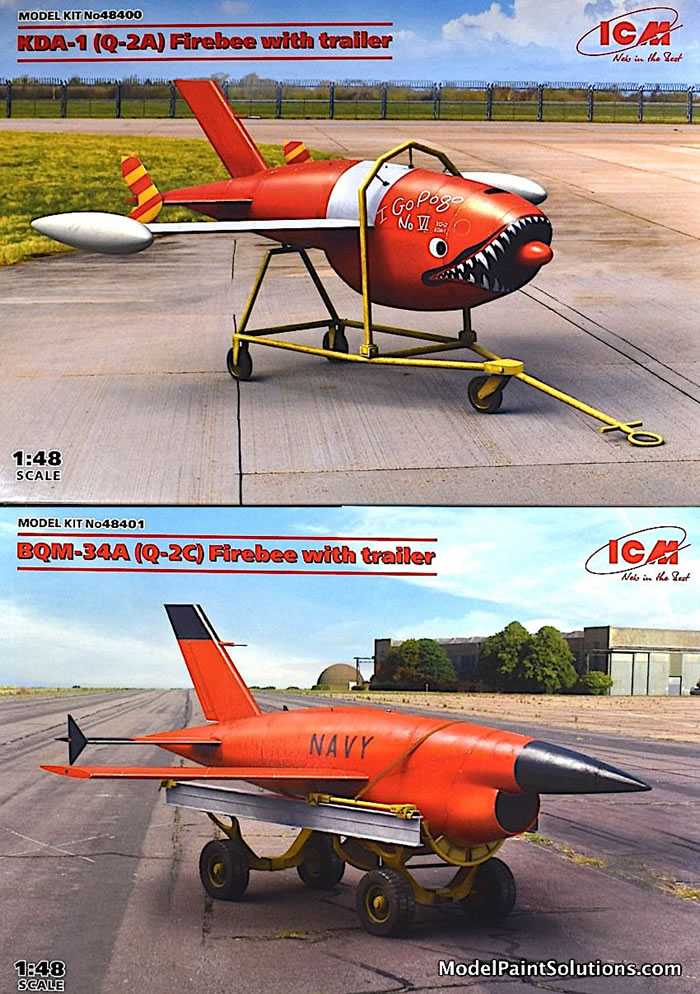
ICM, 1/48 scale
S
u m m a r y : |
Description and Item No.: |
ICM Kit Nos.
48400 - BQM-34C Firebee Drone
48401 - KDA-1 Firebee Drone |
Contents and Media: |
KDA-1 (Q2-A)—48400 The kit is comprised of 34 parts in grey styrene (not all are used) and one decal sheet with markings for 3 airframes.
BQM-34C/Q-2C—48401 The kit is comprised of 41 parts in grey styrene (not all are used) and one decal sheet with markings for 4 airframes.. |
Price: |
(Q2-A) ICM48400
£13.17 Plus Shipping from Hannants
BQM34C/Q-2C—ICM48401
£13.17 Plus Shipping from Hannant
|
Scale: |
1/48 |
Review Type: |
First Look |
Advantages: |
Conventional engineering and a low parts count suggest both kits will be quick builds. |
Disadvantages: |
Some recessed detail may need refreshing prior to primer and paint. |
Recommendation: |
The layout of both kits is simple and straightforward with no apparent issues laying in wait. With such low parts counts and multiple single-piece parts (wings and horizontal stabilizers), both kits will be quick and easy builds. Likewise, both kits provide markings for multiple, colorful schemes that will enhance what are some very nice models. Highly recommended! |
Reviewed by John Miller

Background:
The Ryan Firebee is a series of target drones developed by the Ryan Aeronautical Company beginning in 1951. It was one of the first jet-propelled drones, and remains one of the most widely used target drones ever built.
The Firebee I was the result of a 1948 U.S. Air Force request and contract to Ryan for a jet-powered gunnery target. The first flight of the XQ-2 Firebee prototype took place in early 1951. The drone featured swept flight surfaces and a circular nose inlet. The initial models had distinctive "arrowhead" shaped endplates on the tailplane. The Firebee could be air-launched from a specially modified launch aircraft (Douglas A-26 Invader was first to be used for this), or ground-launched with a single RATO booster.
Following successful evaluation, the XQ-2 was ordered into production for the USAF as the Q-2A, powered by a Continental J69-T-19B turbojet engine with 1,060 pounds-force (4.7 kN) of thrust. The Air Force then obtained small numbers of Q-2B’s with a more powerful engine for high-altitude performance.
The U.S. Navy bought the Firebee as the KDA-1, which was mostly similar to the Q-2A; differing mainly in its powerplant—a Fairchild J44-R-20B turbojet with 1,000 lb (4.4 kN) thrust. The KDA-1/Q-2A could be distinguished by the protruding inlet centerbody and wider, steeply raked inlet. The U.S. Army also obtained a version designated the XM21 that differed only in minor details.
The Navy obtained several improved variants of the KDA-1, including the XKDA-2 and XKDA-3 which were not built in quantity, and the KDA-4, which was the main production version for the series. These variants were difficult to distinguish from the KDA-1, differing mainly in successively uprated J44 engines and other minor changes.
Model 124/BQM-34A/Q2-C
In the late 1950s, the USAF awarded Ryan a contract for a substantially improved "second generation" Firebee, the Model 124, originally with the designation Q-2C. The initial prototype performed its first flight in late 1958 and went into production in 1960. In 1963, it was re-designated the BQM-34A. The old first-generation KDA-1 and KDA-4 targets then still flying with the Navy were (somewhat confusingly) given the respective re-designations AQM-34B and AQM-34C.
The BQM-34A/Q-2C emerged as the Firebee as it is recognized today, with a bigger airframe, longer wings, and a particular "chin"-type inlet under a pointed nose (in contrast to the circular intake of the first-generation Firebees). It was powered by a Continental J69-T-29A turbojet, a copy of the improved Turbomeca Gourdon derivative of the Marbore, with 1,700 lb (7.6 kN) thrust. The U.S. Navy also adopted the BQM-34A, while the Army obtained a ground-launched version designated MQM-34D with longer wings and a heavier JATO booster.
A feature of the second-generation Firebee is that some photographs show it to have triangular endplates on the tailplane, while others show no endplates but feature a ventral fin under the tail, and still others have neither endplates nor ventral fin. Since most modern photographs of Firebees show the ventral fin, this may have been due to production changes or later refits (reference sources are unclear on this).
In 1960 the first stealth technology development program was initiated by USAF, by reducing the radar cross-section of a Q-2C drone. This was achieved through specially designed screens over the air intake, radiation-absorbent material on the fuselage, and a special radar-absorbing paint.
(Edited from Wikipedia)
Yes, the evil owner of Skyway Models was in rare form when he stocked these two kits. Both score very high on the novelty scale, both are comprised of relatively few parts, both offer decals for very colorful schemes, and both will be great quick-build kits that will serve as a break from more demanding builds. Both had to come home with me. I know you understand.
The kits arrive in the sturdy, double-lidded boxes of the type usually used by ICM and previously praised by this reviewer. These boxes have a separate, integral cardboard lid under the box-art lid. This makes for a box sufficiently sturdy for stacking with no concerns of the boxes becoming deformed from weight.
The grey styrene sprues are sealed re-useable bags The decals, with a wax-paper protective covers, are stored within the folded instructions. The first impression of each is one of simplicity. There are very few parts on the sprues. The inscribing is crisp if not a bit light in some areas. There is very little flash even on the smaller parts meaning a minimum of time will be spent on clean up. Both kits include well-molded and nicely detailed carts for displaying the assembled drones. Likewise, both kits include markings for multiple, colorful schemes that will make for head-turning models when assembled.
KDA-1/Q-2A Firebee (Kit# 48400)
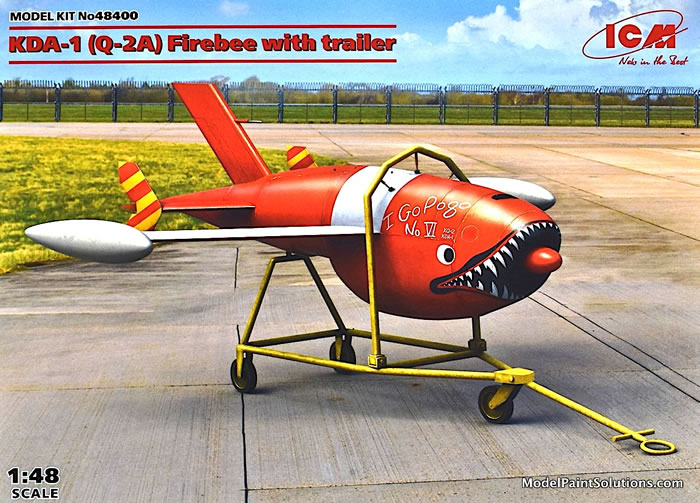
Assembly of the engine (from halves) is followed by assembly of the rounded engine intake, also from halves. Careful filling and buffing will be required to ensure there is no seem along this intake as it will be quite prominent when the kit is assembled.
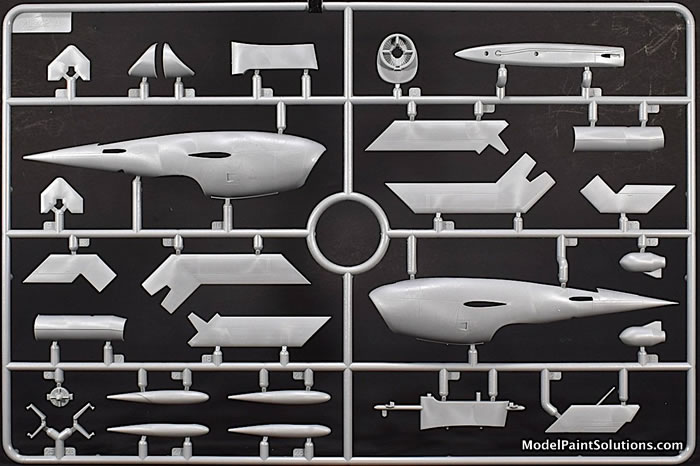
The assembled engine is captured between the fuselage halves followed by addition of the wings and horizontal stabilizers (also from halves). Addition of the vertical stabilizer and horizontal stabilizer end plates completes the build.
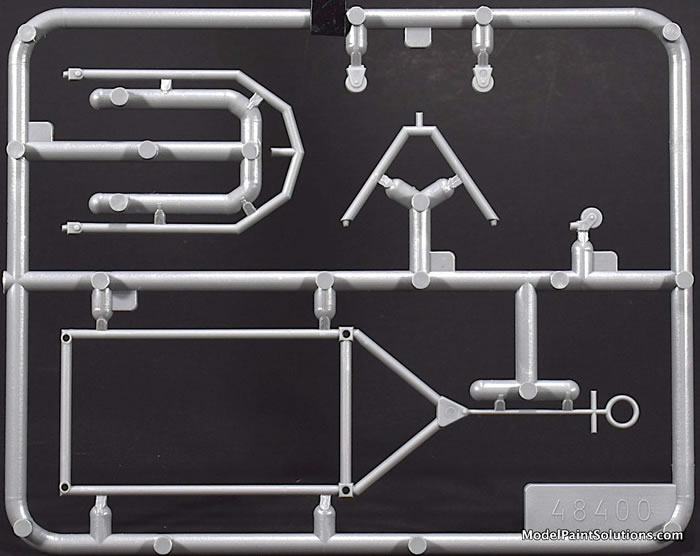
The 6-piece cart is nicely molded and features two castering wheels and supports for the assembled drone.
Markings
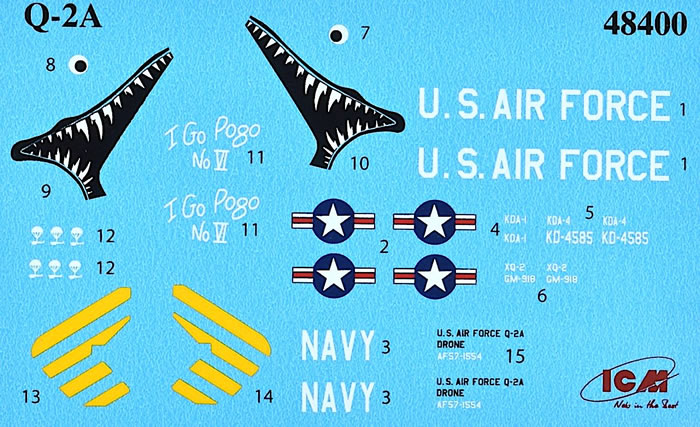
The decal sheet, printed by ICM, has good registration and color density.r Forve Markings for three colorful schemes are provided as follows:
-
Q2-A Firebee, U.S. Air Force, circa 1951.
-
KDA-1 Firebee, Naval Ordinance Test Center, China Lake, California (USA), circa 1960.
-
U.S. Navy XQ-2 prototype, circa 1950.
BQM-34A/Q-2C Firebee (Kit# 48401)
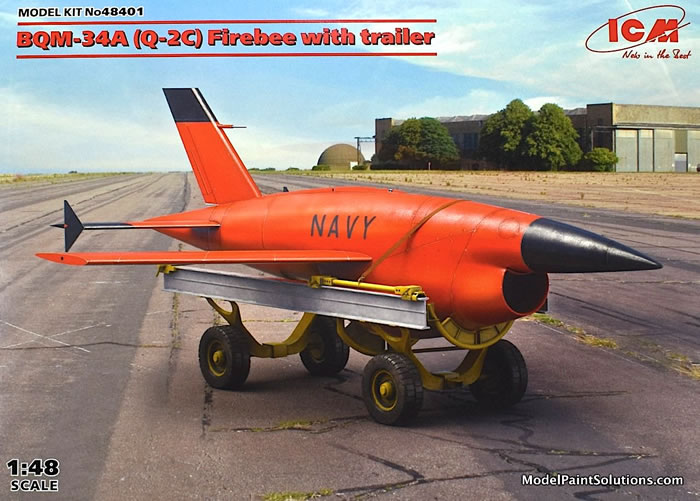
The engine has both intake and exhaust plugs that are trapped between engine halves. The assembled engine is captured between the fuselage halves, which is completed by the addition of a dorsal spine piece.

The single-piece wings are added next followed by the single-piece horizontal stabilizers. Addition of the single-piece vertical stabilizer is next followed by the horizontal stabilizer end plates. The end plates are appropriate for schemes 1 and 4; schemes 2 and 3 are sans end plates.
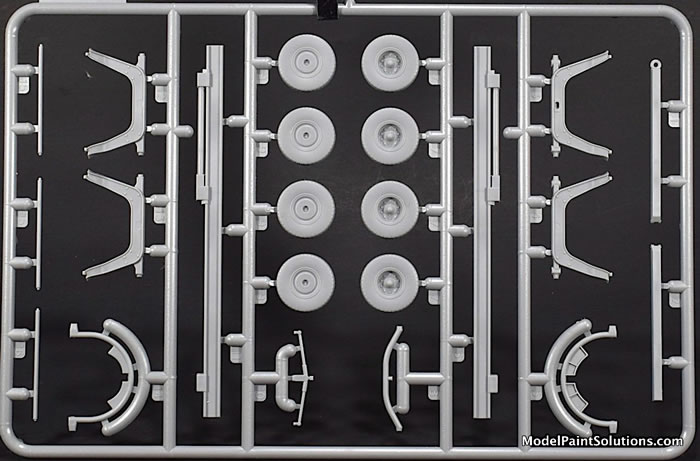
This is going to be a quick build :)
The cart is comprised of 23 nicely molded parts and features 4 large wheels/tires (comprised of halves).
Color and Markings:

The decal sheet, by ICM, has good registration and color density. Markings for four colorful schemes are provided as follows:
-
U.S. Navy BQM-34 Firebee Target Drone, Naval Base, Ventura, California, USA.
-
U.S. Navy BQM-34 Firebee Target Drone, completed 36 successful missions.
-
U.S. Air Force BQM-34 Firebee Target Drone, Wallace Air Station, the Philippines.
-
U.S. Navy BQM-34 Firebee Target Drone, circa 2000.
The layout of both kits is simple and straightforward with no apparent issues laying in wait. With such low parts counts and multiple single-piece parts (wings and horizontal stabilizers), both kits will be quick and easy builds. Likewise, both kits provide markings for multiple, colorful schemes that will enhance what are some very nice models. Highly recommended!
Now go paint something!
--John
For more on this review visit Modelpaintsolutions.com:
https://modelpaintsol.com/reviews/icm-48-firebee-drones-48400-and-48401
Review kit provided by my retirement fund, again.
Text and Images Copyright © 2021 by Model Paint Solutions
Page Created 28 July, 2021
Last updated
28 July, 2021
Back to HyperScale Main Page
Back to Reviews Page
|
Home
| What's New |
Features |
Gallery |
Reviews |
Reference |
Forum |
Search